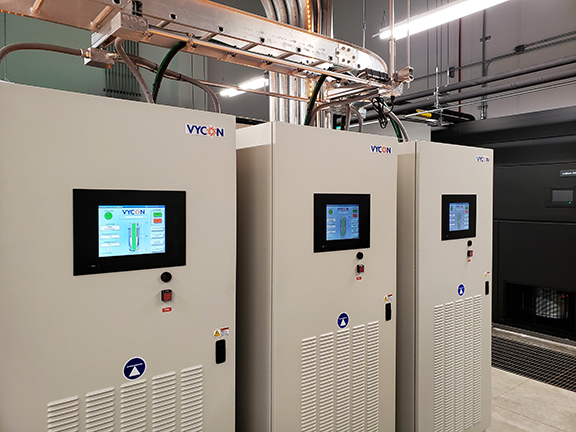
There are several ways to make existing data centers more energy-efficient, such as with the adoption of technologies that can impact both consumption and bottom line.
John Jeter of VYCON explains more.
VYCON specializes in clean energy solutions and the company manufactures environmentally-friendly, high-speed flywheel systems. This kinetic energy technology is designed to provide a greener, cost-saving solution as compared to traditional Uninterruptible Power Supply (UPS) systems that are reliant upon conventional batteries.
To gain an insight into the technology, Digital Journal caught up with VYCON’s John Jeter, Director of Sales.
Digital Journal: Why do you consider clean energy to be important?
John Jeter: Being kinder to our planet is vital for our existence. We must be ever vigilant on how we use natural resources in order to lessen the impact of our carbon footprint. Fossil fuels pollute our air, water and land causing innumerable long-lasting problems for our environment and well-being. Over the past decade, governments, corporations and individuals have made great strides in implementing renewable energy to combat global warming.
According to the Environment America Research & Policy Center and Frontier Group, the U.S. has increased solar power generation by 40-fold and increased the use of wind by 275 percent. Implementing renewable energy and energy-efficient solutions – such as energy storage – have far-reaching benefits not just from an economic perspective, but from a human health perspective as well. One industry that has made it a goal to reduce its carbon footprint is data centers. The mega-giant data center and co-location providers such as Amazon, Apple, Google, Microsoft, and others are leading the way with utilizing renewable energy sources. Data centers are also being located underground and even underwater to take advantage of cooler ambient temperatures. Microsoft recently announced that by 2030 it will be carbon-negative and is strongly urging its supply chain to pitch-in. “We need to continue to advance human prosperity,” declared Microsoft President Brad Smith. “We will need to continue to generate and use more energy. But we need to cut the cord with carbon.”
DJ: How do you define ‘clean energy’? What are the key methods of power generation?
Jeter: Solar, wind, geothermal, hydroelectric and energy storage are all contributing to lowering carbon emissions. However, for solar and wind, there are challenges in that they can’t produce power when its dark or there’s no wind. This is where energy storage – the space we’re in – comes into play. Energy storage systems such as flywheels and batteries enable stored energy to be released providing a continuous flow of clean energy during peak demand.
DJ: What is your flywheel system?
Jeter: VYCON’s VDC Direct Connect UPS back-up systems provide instantaneous and reliable back-up power for today’s mission-critical facilities and applications – data centers, hospitals, microgrids, electric rail and more. Our VDC and REGEN flywheels store kinetic energy in the form of a rotating mass and are designed for high power, short discharge applications. VYCON’s patented technology includes a high-speed motor generator, active magnetic bearings that are used to levitate and sustain the rotor during operation, and a superior control and monitoring system that can provide information on system performance. These innovative technologies enable the flywheel systems to charge and discharge at high rates for countless cycles making conventional technologies like batteries obsolete for many use cases.
DJ: What advantages does this system have over traditional battery-operated systems?
Jeter: With its 20-year lifespan, our patented flywheel systems significantly improve critical system uptime and eliminate the environmental hazards, costs and continual maintenance associated with toxic lead-acid based and fire-prone lithium-ion batteries used with three-phase uninterruptible power supplies (UPSs). For data center applications, by replacing UPS lead-acid batteries with flywheels, our customers achieve tremendous advantages, including lower costs and reduced carbon footprint. Lead-acid batteries are very unpredictable, heavy, require ongoing maintenance, spill containment compliance and take up a lot of expensive real estate.
For example, the footprint of our flywheels compared to batteries represent 30% to 50% reduction in floor space over the use of batteries. Driving down costs and increasing data center system uptime are motivating important initiatives such as energy efficiency, sustainability and reliability. VYCON’s VDC flywheel technology eliminates the need for costly cooling in a fraction of the space compared to banks of back-up batteries. The VYCON REGEN flywheel systems can capture regenerative energy repetitively that normally would be wasted as heat, deliver significant energy savings and reduce fuel costs while decreasing a full range of toxic emissions. In short, the VYCON technology is a vital, first step toward achieving clean, reliable and sustainable energy efficiency.
DJ: How much power does it take to run a data center for a large enterprise? Can you match these power demands with your technology?
Jeter: Data centers power requirements vary, but lately we have seen them going to larger power building blocks of 675KW to 1500KW and even as high as 2000KW. VYCON’s VDC-XXT is particularly well suited to this approach and you can add flywheels as the load demands grow. This allows for scalability. Example: to provide enough ride through time for the utility to emergency transfer you would need 2 VDC-XXT for 675 kW, 3 for 1000 kW and 6 for a 2,000 kW load.
DJ: Which types of clients do you work with? Jeter: Data center and co-location facilities, hospitals, government, electric rail and microgrid/renewable operators.

